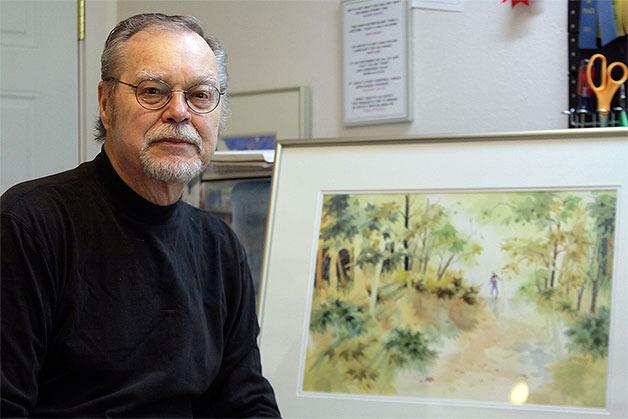The painting speaks to Randy Emmons.
With shades of green and yellow, it reveals a tall figure at the top of a hill, holding a walking stick as he navigates a wooded trail.
Unlike most of Emmons’ watercolor paintings, this one doesn’t reflect a particular setting that happened to catch his attention during one of his own travels.
Yet it reflects his own personal journey and perspective.
“It has a feeling of ‘life is good,’ ” Emmons said, revealing the painting’s name. “It’s the way I feel right now.”
Emmons, a retired lieutenant commander in the Navy, has no complaints about life.
He and his wife live on 2.5 wooded acres in a home that they designed and had built near Crescent Harbor on North Whidbey.
It’s a peaceful country backdrop for an accomplished, award-winning watercolor artist who constantly looks to the outdoor landscape for inspiration.
In his home studio, Emmons creates roughly 30 paintings a year, revealing scenes of Whidbey Island and other nearby images that catch his eye.
His “Life is Good” painting caught the attention of others.
 It was recently selected to be part of the 75th Annual International Open Exhibition in Seattle this summer.
It was recently selected to be part of the 75th Annual International Open Exhibition in Seattle this summer.
Emmons is one of 86 artists whose works will be on display. His painting was chosen by internationally known juror Judy Morris out of 600 entries from seven countries and 24 states.
The exhibition takes place July 1 through Sept. 30 at the Washington State Convention Center.
“I’ve been in these shows before,” Emmons said. “This one is a really big one.
“There are some nationally renowned artists in this show. It’s good to be bumping paintings with them.”
The honor is even more profound considering Emmons didn’t have the strength to hold a paint brush three years ago.
In 2012, Emmons was diagnosed with lymphoma, a type of blood cancer, and needed a stem cell transplant.
The cancer treatment, which included chemotherapy, covered two years and involved close monitoring, regular follow-ups and a lengthy hospital stay. It was compounded by appendicitis during the time of the stem cell transplant.
“I had to be isolated for a year to get my immune system back,” Emmons said. “I couldn’t be around people. There was no shaking hands.
“I was pretty whooped. I was so weak I couldn’t draw. I couldn’t even sign my name. I was in the hospital so long, I couldn’t walk. It was pretty hairy.”
Bev McQuary, a fellow artist from Penn Cove Gallery, said the entire ordeal was horrendous.
“Randy is a total sweetheart and a really good friend,” McQuary said. “He’s actually one of the nicest people you’re ever going to meet on the face of this earth.
“What’s he’s gone through in health nearly took him out. He had to learn to draw all over again before he could start painting again.”
Emmons, 68, doesn’t like to focus on the past and instead chooses to look forward.
He’s grateful that follow-up visits have revealed no return of the cancer and is glad to have regained his strength and be back painting again.
He’s been prolific behind his easel the past two years, turning out new paintings, and is focused on family. He and his wife Joan Carr-Emmons have nine grandchildren.
“Life’s looking good,” Emmons said.
Exposed to painting in his youth while growing up in Monterey, Calif., Emmons expected to be a full-time artist one day but put that ambition on hold until after his naval career.
In the Navy, he pursued the closest thing to art he could find and chose a career in photojournalism.
Emmons has dedicated his work to watercolor painting full time since 2006. His paintings appear at Penn Cove Gallery in Coupeville and at the Artist’s Remarque in La Conner.
A signature member of the Northwest Watercolor Society, Emmons has won numerous awards for his paintings and his works have been selected for the posters of three different festivals.
“He is incredibly prolific,” McQuary said. “I don’t know how he does it. He just turns them out like pizzas.”
In reality, Emmons produces on average a little more than two paintings a month.
Two keepers, that is.
“I paint stinkers, too,” he said with a laugh.
He pointed to a crumbled up painting he discarded in his studio trash can.
“I get defeated really fast. My stinker rate is pretty high,” he said.
He said he guesses that’s why he chose not to teach art. He joked that his students would see these imperfections.
The thought of that makes McQuary laugh.
“I’d love to scrump through his garbage can,” she said.


